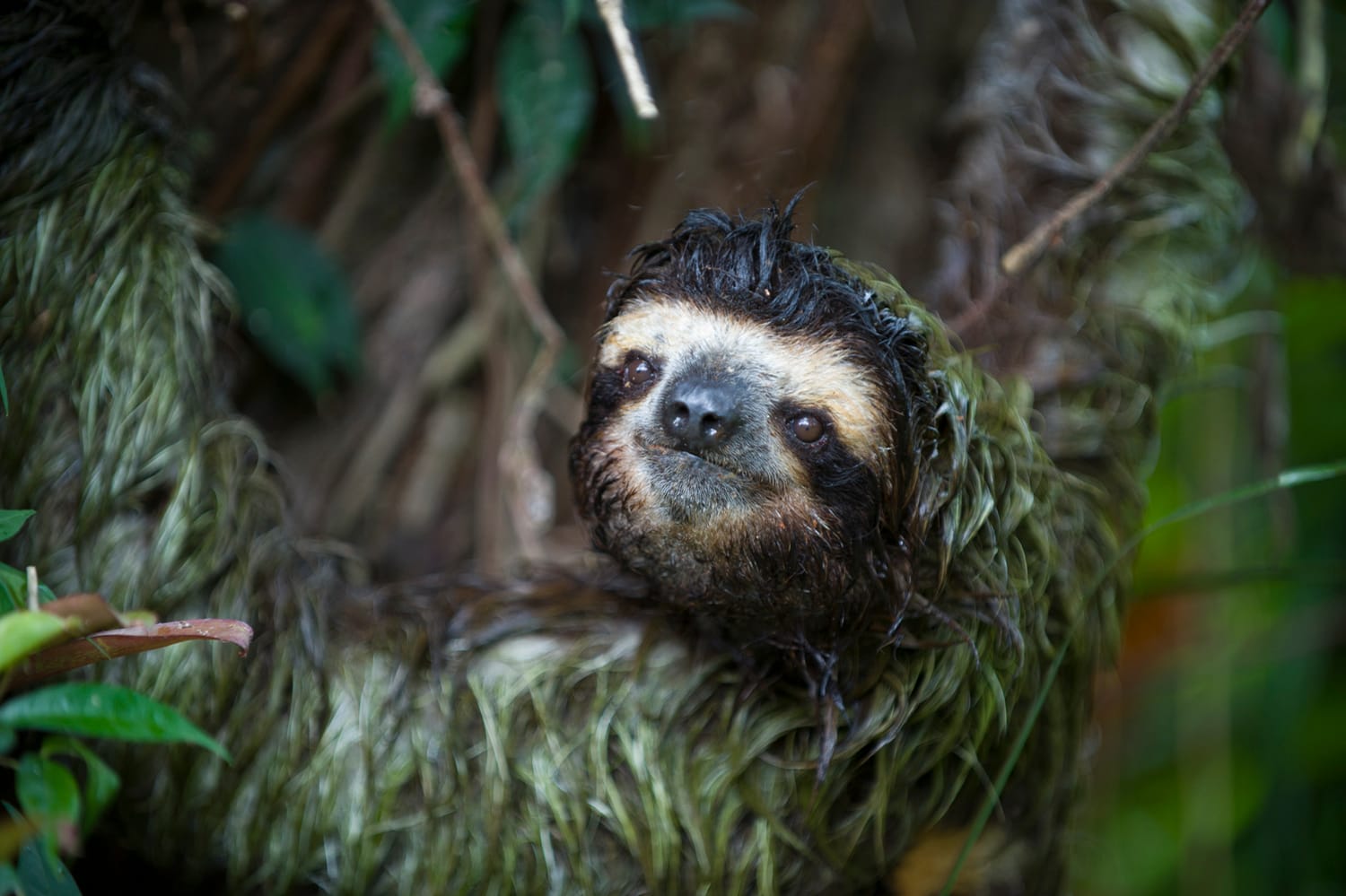Unseen Crisis in Paradise
Deep within the vibrant rainforests of Costa Rica and Panama, a silent crisis is unfolding. Sloths, known for their slow and peaceful nature, are facing a new challenge: deformities, especially in their limbs. These aren’t just isolated cases; the number of sloths exhibiting these deformities appears to be increasing, alarming conservationists.
What’s Behind the Deformities?
Habitat fragmentation, driven by roads and development, is considered a primary culprit. As their rainforest homes are carved up, sloths become isolated in smaller areas, limiting their mating options. This leads to inbreeding, increasing the likelihood of offspring inheriting harmful genetic mutations—mutations that likely contribute to the deformities being observed.
Scientists Seek Answers
Dedicated researchers at the Sloth Conservation Foundation (SCF) are working tirelessly to unravel this mystery. By collecting hair samples from sloths, they can analyze their genetic makeup, identify family groups, and determine which populations might be most vulnerable to these deformities. This genetic detective work is crucial for understanding the overall health of sloth populations.
A Life Disrupted
While some sloths with deformities manage to survive, their lives are undeniably more challenging. Navigating the dense rainforest, finding food, and raising a family become monumental tasks when their bodies don’t function as they should. Scientists are still working to determine the full impact of these deformities on a sloth’s lifespan and overall well-being.
A Ripple Effect
The plight of deformed sloths serves as a stark reminder that disrupting even one element of an ecosystem can have far-reaching consequences. Habitat loss doesn’t just harm sloths; it throws the entire delicate balance of nature into disarray.
Hope on the Horizon
Thankfully, dedicated individuals and organizations like the SCF are fighting for these gentle creatures. Through research, fundraising campaigns, and advocacy for habitat protection, they are working to secure a future for sloths.
What Can You Do?
We can all play a role in safeguarding these vulnerable animals. By supporting organizations like the SCF, spreading awareness about the plight of deformed sloths, and advocating for responsible environmental practices, we can help ensure these incredible creatures continue to grace our planet for generations to come.
Unlocking the Mystery: Why Are Some Sloths Deformed?
We all know and love sloths for their leisurely pace, but the reality is that some face a tougher existence due to physical deformities. So, what’s contributing to this troubling trend?
Unraveling the Complexities
There is no single answer; it’s a multifaceted issue with several likely contributors. One suspect is genetics. Like humans, sloths can inherit genes from their parents that predispose them to certain conditions, including deformities. Habitat loss, forcing sloths into smaller territories and limiting their mating choices, exacerbates this issue. Inbreeding within these smaller populations increases the chances of passing down harmful genetic mutations.
The Human Factor
Human activities have significantly impacted the environment, and sloths are bearing the brunt of it. Deforestation, the rampant destruction of forests, not only destroys their homes but also forces them into ever-shrinking areas, increasing the likelihood of inbreeding. Additionally, pesticides used in agriculture can contaminate their food sources and environment, potentially causing harm to these vulnerable creatures.
A Matter of Survival
While a slightly crooked claw might seem insignificant, in the sloth world, even seemingly small deformities can have a significant impact on survival. Imagine trying to hang upside down or move through the rainforest canopy with a deformed limb. Deformities make it harder to travel, find food, escape predators, and attract mates, ultimately impacting their ability to thrive.
Hope for the Future
Organizations like the Sloth Conservation Foundation are working tirelessly to understand the causes of these deformities and find ways to prevent them. Their research into sloth genetics and their efforts to protect sloth habitats offer a beacon of hope for these gentle creatures.
Unveiling the Truth About Deformed Sloths: A Closer Look
Let’s delve deeper into the world of deformed sloths, moving beyond the fictionalized portrayal in movies like “The Goonies” to understand the real-life challenges they face.
Recognizing the Signs
The deformities affecting sloths aren’t always dramatic; they’re often subtle but still impactful. Imagine a sloth with missing or misshapen toes and fingers, differently developed ears, or limbs that are twisted or shorter than usual. In some cases, sloths might even exhibit albinism, a condition resulting in a complete lack of pigmentation. While these might appear to be minor variations, they can have a devastating impact on an animal that relies on its physical abilities to survive in the trees.
A Struggle for Survival
A sloth’s claws are essential for hanging upside down, moving between branches, and navigating their arboreal world. Deformities affecting their limbs hinder their ability to travel efficiently, find food, and escape danger, ultimately impacting their chances of survival and reproduction.
A Reflection of Environmental Health
These deformities aren’t merely random occurrences; they often signal a much larger problem: a distressed environment. Sloths inhabit rainforests, some of the most fragile ecosystems on Earth. Pollution from pesticides, habitat destruction, and other human-caused issues can disrupt a sloth’s development, even before birth. The presence of deformed sloths serves as a warning sign, urging us to protect these delicate ecosystems, not just for the sloths, but for all the creatures that depend on them.
A Call to Action
Thankfully, scientists and conservationists are diligently studying these deformities, working to pinpoint their causes and develop strategies for prevention. Their efforts to protect sloth habitats and educate the public about the importance of conservation are crucial steps in the right direction. By learning about sloths, supporting organizations dedicated to their protection, and making environmentally conscious choices, we can contribute to a brighter future for these gentle and extraordinary animals.
Can Sloths Fall 100 Feet Without Injury? Unraveling the Science of the Slow Fall
The Myth and the Reality
Sloths are notoriously slow-moving, but did you know they’re also surprisingly resilient? A common claim circulating is that sloths can fall from heights of 100 feet or more without sustaining injuries. While this might seem outlandish, there’s a fascinating scientific explanation behind their ability to withstand such tumbles.
Built for Impact
Sloths possess unique anatomical features that act as natural shock absorbers, protecting them during falls. Their necks, for instance, are longer than those of most mammals, with extra vertebrae that provide remarkable flexibility and help distribute the force of impact. Additionally, their joints are held together by exceptionally strong ligaments, acting like heavy-duty rubber bands to prevent dislocations and fractures upon landing.
The Advantage of Slowness
Believe it or not, a sloth’s leisurely metabolism and low muscle mass actually contribute to their fall survivability. Their slow movements and reduced weight mean they fall at a slower rate, lessening the impact force upon landing.
Frequent Flyers
Studies suggest that sloths, despite their seemingly clumsy nature, actually fall from trees about once a week throughout their lives. This frequency highlights their remarkable tolerance for tumbles and suggests that falling is a natural part of their existence in the canopy.
Limits to Resilience
While sloths are remarkably adapted to withstand falls, it’s important to remember that there are limits to their toughness. A fall from an extreme height or an unfortunate landing on a hard surface could still result in serious injury or even death.
Deforestation: A Growing Threat
Sadly, deforestation is making falls increasingly risky for sloths. As humans continue to decimate their forest homes, sloths are forced to navigate unfamiliar territory, often encountering roads, powerlines, and other hazards that increase their chances of a dangerous fall.
A Testament to Adaptation
The ability of sloths to survive falls from significant heights is a testament to the power of natural selection and adaptation. Their unique anatomy and physiology highlight the remarkable diversity of life on Earth and the incredible ways animals evolve to thrive in their environments. By learning about and protecting these fascinating creatures, we can help ensure that they continue to amaze us with their incredible survival skills for generations to come.
If you ever wonder what the largest spider in the world is, head over to our page on the Darwin’s bark spider! This spider has a leg span of up to 12 inches and is native to Madagascar. Our page also has more information about the deformed monkey, which is also found in Madagascar. The deformed monkey is one of the most endangered primates in the world, with only about 100 individuals remaining in the wild.
















